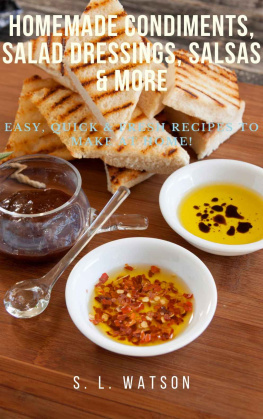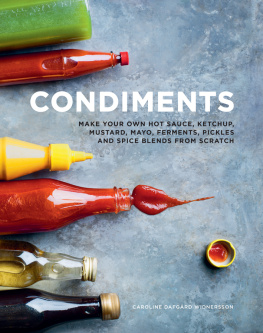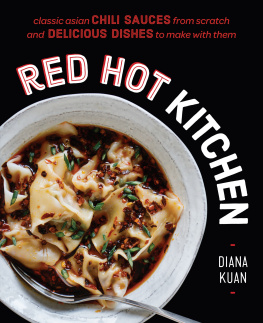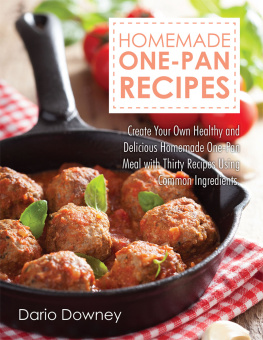
Text Copyright 2013 Jessica Harlan. Photographs copyright JudiSwinksPhotograpy.com. Illustrations copyright 2013 Karen Bottiani. Design and concept copyright 2013 Ulysses Press and its licensors. All rights reserved. Any unauthorized duplication in whole or in part or dissemination of this edition by any means (including but not limited to photocopying, electronic devices, digital versions, and the Internet) will be prosecuted to the fullest extent of the law.
Published by
Ulysses Press
P.O. Box 3440
Berkeley, CA 94703
www.ulyssespress.com
ISBN: 978-1-61243-251-9
Library of Congress Catalog Number 2013938280
10 9 8 7 6 5 4 3 2 1
Acquisitions editor: Keith Riegert
Project editor: Alice Riegert
Editor: Susan Lang
Proofreader: Jessica Benner
Layout and design: what!design @ whatweb.com
Photography: Judi Swinks Photography
Food stylist: Anna Hartman-Kenzler
Illustrator: Karen Bottiani
Index: Sayre Van Young
Distributed by Publishers Group West
IMPORTANT NOTE TO READERS: This book is independently authored and published and no sponsorship or endorsement of this book by, and no affiliation with, any trademarked brands or other products mentioned or pictured within is claimed or suggested. All trademarks that appear in this book belong to their respective owners and are used here for informational purposes only. The author and publishers encourage readers to patronize the quality brands and products mentioned in this book.
to Kevyn Lloyd Aiken
Contents

Condiments are like old friends highly thought of, but often taken for granted, once quipped Marilyn Kaytor, one of Americas first true food journalists.
Stop for a moment and think about a world without condiments: would a hot dog be as delicious without its blanket of ketchup, mustard, and relish? How sad would a salad be without a drizzle of dressing? Bread would be dry and dull without a slathering of jam, and even the most delicious ice cream is all the better when its topped with hot fudge or caramel sauce.
If youve picked up this book, chances are you have a refrigerator door full of bottles of mustard, mayonnaise, pickles, and other condiments, and youre wondering if there are better options than the mass-produced, commercial brands on the supermarket shelves.
Indeed, there are. On the pages of this book youll find true alchemy: how to break down a basket of ripe tomatoes from your garden into a jar of ruby-red ketchup. How to whip up the perfect salad dressing to complement tonights dinner, all with ingredients you already have in your pantry. How to custom-blend a hot sauce so that its just spicy enough for your palate.
Stick with me, and you might never have to buy another bottle of commercially prepared condiment again.
Why Make Your Own?
As youll learn on the following pages, making your own condiments is easy and fun. And there are many advantages to making condiments yourself instead of purchasing them.
Youll know exactly what goes into each batch. Many commercial condiments like ketchup, dressings, and hot sauces contain high fructose corn syrup, artificial flavorings, preservatives, MSG, and other undesirable ingredients. And who knows what the generic term natural flavorings, so often included in the list of ingredients, means?
You can use fresh, locally grown and natural or organic ingredients. Many of the recipes in this book can be made with herbs, fruits, and vegetables grown in your own backyard or bought at a farmers market or natural food store. Not only are homemade condiments a great way to make use of seasonal bounty, but theyll be fresher and, in many cases, healthier than store-bought versions.
You can customize your condiments according to your palate and your needs. Make a sauce spicier or milder, reduce the amount of oil or salt in a salad dressing to be a little healthier, or alter a tartar sauce recipe to complement the type of fish youre cooking.
Its fun! There is no small satisfaction in taking fresh produce and seeing the magic unfold as it transforms into a flavorful condiment. Its particularly exciting for small children to learn exactly where their food comes from. My children loved watching pounds and pounds of fresh tomatoes morph into a jar of ketchup.
Homemade condiments make wonderful gifts. Use one of the recipes in this book to create your own condiments, package them in gorgeous jars or bottles, create fun custom labels, and give them as gifts. They make fantastic stocking stuffers, hostess gifts, or even party or wedding favors.
Condiments: A Brief History
I like to imagine a cave man biting into his woolly mammoth steak and imagining that a little dash of spice might jazz it up. And indeed early condiments like salt, pepper, and herbs, were likely used as a way to add interest to bland, monotonous foods at a time when there was little variety in what humans ate.
According to The Oxford Companion to American Food and Drink, condiments have been in use in America since colonial times and were at first on the tables of only those who could afford them. Most common were jams and jellies, mustards, salt, and pepper. Early American housewives soon learned to put up pickled vegetables, jams, and other produce-based canned foods for the long winter, and jars of these foods would sustain them until the spring, when they could once again grow or forage for fresh fruits and vegetables.

By the 19th century, condiments would become a matter of controversy: activists spoke out against condiments. Dietary reformer Sylvester Graham accused them of being highly exciting and exhausting, while physician and temperance leader Dio Lewis encouraged his followers to shun mustard, ketchup, and other flavor enhancers, railing, Everything which inflames one appetite is likely to arouse the other also.
Luckily for us, Americans had already developed an appetite for condiments, and their popularity has grown ever since, particularly as ingredients and manufacturing processes became less expensive. The emergence of fast food in the middle of the 20th century helped spur the popularity of ketchup, mustard, and mayonnaise, and the accessibility of different cultures, through travel, the media, and immigrant populations increased the presence of international ingredients and condiments available to us in American supermarkets and restaurants.
Setting Up Your Pantry
Keeping a number of staples on hand, and having access to fresh, good-quality produce, will ensure that you will always be ready to make your own condiments.
The Staples
Vinegars: Many of the condiments in this book require the use of different varieties of vinegar. Not only does vinegar add a flavorful acidic note to a condiment, but it also acts as a natural preservative. The acetic acid in vinegar (commercially available vinegars contain between 4 and 7 percent acidity) can inhibit the growth of many microbes, molds, and bacteria (which is why vinegar can double as a homegrown cleaning solution). Vinegar can be made from any fruit or anything containing sugar (typically fruits or grains), but there are certain kinds of vinegar that are most frequently used in this book. White vinegar is the least expensive and most common vinegar, and its one of the purest forms of acetic acid; its derived from pure alcohol and has a very straightforward, simple flavor. Cider vinegar, which is yeast-fermented apple juice, has a fruity, sweet-tart flavor that works nicely in certain ketchup and mustard recipes, and in hot sauces. Wine vinegar is made from a twofold fermentation of grape juice and can be found in either white or red varieties. Sherry vinegar, champagne vinegar, and balsamic vinegar are all varieties of wine vinegar. These types of vinegars are particularly nice in salad dressings. Other vinegar varieties include malt vinegar (derived from malt, or sprouted grain) and rice vinegar (made from sugar derived from rice). A traditional Asian ingredient, rice vinegar has a very mild, almost floral flavor. Be sure to buy plain rice vinegar and not the seasoned kind, which contains sugar. Because of its acidity, vinegar will last indefinitely and doesnt need refrigeration.
Next page










